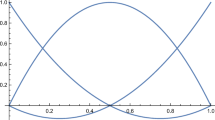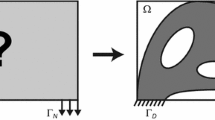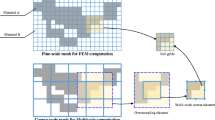Abstract
Multiscale topology optimization (MTO) of structures requires the computationally efficient evaluation of the mechanical properties of each mesoscale representative volume element (RVE). This paper presents a novel method that uses a complementary energy (CE) approach to estimate the effective homogenized properties of an RVE, consisting of an embedded structure that is parametrically defined. Visualizing the meso-scale structure as a sweep cross-section makes it possible to quickly and accurately write the CE and then invoke Castigliano’s second theorem to find the force–displacement relationships. A two-dimensional (2D) running example of an anchored torus is employed to motivate the framework in which Lagrange multipliers are used to ensure the physical constraints on the mesostructure. For three-dimensional (3D) RVEs, a Frenet frame representation is used to associate the global forces and moments to a local coordinate system. Two homogenization methods are compared to ensure correctness; the first directly evaluates the constitutive matrix via the kinetic uniform boundary condition (KUBC) approach, while the second is a new finite element based optimization that directly finds the equivalent material properties. The proposed method is compared at the meso-scale against a solid finite element model and a discrete beam model to verify accuracy. Furthermore, a variety of material properties are demonstrated for a 3D example.

















Similar content being viewed by others
References
Aref AJ, Guo Z (2001) Framework for finite-element-based large increment method for nonlinear structural problems. J Eng Mech ASCE 127(7):739–746
Barham WS, Aref AJ, Dargush GF (2005) Development of the large increment method for elastic perfectly plastic analysis of plane frame structures under monotonic loading. Int J Solids Struct 42(26):6586–6609
Bendsøe MP, Kikuchi N (1988) Generating optimal topologies in structural design using a homogenization method. Comput Methods Appl Mech Eng 71(2):197–224
Bendsoe MP, Sigmund O (2003) Topology optimization: theory, methods, and applications. Springer Science & Business Media, Berlin
Bielecki D, Patel D, Rai R, Dargush GF (2021) Multi-stage deep neural network accelerated topology optimization. Struct Multidisc Optim 64(6):3473–3487
Boisse PH, Ladeveze P, Rougee P (1989) A large time increment method for elastoplastic problems. Eur J Mech A 8(4):257–275
Bouhamed A, Jrad H, Mars J, Wali M, Gamaoun F, Dammak F (2019) Homogenization of elasto-plastic functionally graded material based on representative volume element: application to incremental forming process. Int J Mech Sci 160:412–420
Castigliano A (1879) Théorie de l’équilibre des systèmes élastiques et ses applications, vol 1. AF Negro
Coelho PG, Fernandes PR, Guedes JM, Rodrigues HC (2008) A hierarchical model for concurrent material and topology optimisation of three-dimensional structures. Struct Multidisc Optim 35(2):107–115
Dassault Systemés Simulia Corp. (2022) Abaqus Unified FEA, version 2022. Dassault Systemés Simulia Corp., Providence
Felippa CA (1987) Will the force method come back? J Appl Mech 54:726–728
Hoang V-N, Tran P, Van-Tuyen V, Nguyen-Xuan H (2020) Design of lattice structures with direct multiscale topology optimization. Compos Struct 252:112718
Holmberg E, Torstenfelt B, Klarbring A (2013) Stress constrained topology optimization. Struct Multidisc Optim 48(1):33–47
Howell LL (2013) Compliant mechanisms. In: 21st century kinematics. Springer, pp 189–216
Hu S, Lundgren M, Niemi AJ (2011) Discrete Frenet frame, inflection point solitons, and curve visualization with applications to folded proteins. Phys Rev E 83(6):061908
Huet C (1990) Application of variational concepts to size effects in elastic heterogeneous bodies. J Mech Phys Solids 38(6):813–841
Junjian F, Sun P, Yixian D, Li H, Zhou X, Tian Q (2022) Isotropic design and mechanical characterization of TPMS-based hollow cellular structures. Compos Struct 279:114818
Kota S, Ananthasuresh GK (1995) Designing compliant mechanisms. Mech Eng CIME 117(11):93–97
Kumar T, Suresh K (2021) Direct Lagrange multiplier updates in topology optimization revisited. Struct Multidisc Optim 63(3):1563–1578
Ladevèze P (1999) Nonlinear computational structural mechanics: new approaches and non-incremental methods of calculation. Springer, Berlin
Liu M, Zhang X, Fatikow S (2016) Design and analysis of a high-accuracy flexure hinge. Rev Sci Instrum 87(5):055106
Liu M, Zhang X, Fatikow S (2017) Design of flexure hinges based on stress-constrained topology optimization. Proc Inst Mech Eng C 231(24):4635–4645
Liu H, Wang Y, Zong H, Wang MY (2018) Efficient structure topology optimization by using the multiscale finite element method. Struct Multidisc Optim 58(4):1411–1430
Martìnez J, Dumas J, Lefebvre S (2016) Procedural voronoi foams for additive manufacturing. ACM Trans Graph 35(4):1–12
Martìnez J, Song H, Dumas J, Lefebvre S (2017) Orthotropic k-nearest foams for additive manufacturing. ACM Trans Graph 36(4):1–12
Martìnez J, Hornus S, Song H, Lefebvre S (2018) Polyhedral voronoi diagrams for additive manufacturing. ACM Trans Graph 37(4):1–15
Martins JRRA, Sturdza P, Alonso JJ (2003) The complex-step derivative approximation. ACM Trans Math Softw 29(3):245–262
McGuire W, Gallagher RH, Ziemian RD (1999) Matrix structural analysis. Wiley, Hoboken
Neuenhofer A, Filippou FC (1998) Geometrically nonlinear flexibility-based frame finite element. J Struct Eng ASCE 124(6):704–711
Omairey SL, Dunning PD, Sriramula S (2019) Development of an Abaqus plugin tool for periodic RVE homogenisation. Eng Comput 35(2):567–577
Patel D, Bielecki D, Rai R, Dargush G (2022) Improving connectivity and accelerating multiscale topology optimization using deep neural network techniques. Struct Multidisc Optim 65(4):1–19
Patnaik S (1973) An integrated force method for discrete analysis. Int J Numer Methods Eng 6:237–251
Pian THH (1964) Derivation of element stiffness matrices by assumed stress distributions. AIAA J 2(7):1333–1336
Przemieniecki JS (1968) Theory of matrix structural analysis. McGraw-Hill, New York
Sigmund O (1997) On the design of compliant mechanisms using topology optimization. J Struct Mech 25(4):493–524
Sigmund O (2009) Systematic design of metamaterials by topology optimization. In: IUTAM symposium on modelling nanomaterials and nanosystems. Springer, pp 151–159
Sivapuram R, Dunning PD, Kim HA (2016) Simultaneous material and structural optimization by multiscale topology optimization. Struct Multidisc Optim 54(5):1267–1281
Sivaselvan MV, Reinhorn AM (2006) Lagrangian approach to structural collapse simulation. J Eng Mech ASCE 132(8):795–805
Sivaselvan MV, Lavan O, Dargush GF, Kurino H, Hyodo Y, Fukuda R, Sato K, Apostolakis G, Reinhorn AM (2009) Numerical collapse simulation of large-scale structural systems using an optimization-based algorithm. Earthq Eng Struct Dyn 38(5):655–677
Spacone E, Ciampi V, Filippou FC (1996) Mixed formulation of nonlinear beam finite element. Comput Struct 58(1):71–83
Squire W, Trapp G (1998) Using complex variables to estimate derivatives of real functions. SIAM Rev 40(1):110–112
Wang Y, Hang X, Pasini D (2017) Multiscale isogeometric topology optimization for lattice materials. Comput Methods Appl Mech Eng 316:568–585
Wang J, Rai R, Armstrong JN (2019) Investigation of compressive deformation behaviors of cubic periodic cellular structural cubes through 3D printed parts and FE simulations. Rapid Prototyp J. https://doi.org/10.1108/RPJ-03-2019-0069
White DA, Arrighi WJ, Kudo J, Watts SE (2019) Multiscale topology optimization using neural network surrogate models. Comput Methods Appl Mech Eng 346:1118–1135
Xue D, Zhu Y, Guo X (2020) Generation of smoothly-varying infill configurations from a continuous menu of cell patterns and the asymptotic analysis of its mechanical behaviour. Comput Methods Appl Mech Eng 366:113037
Ye S, Li B, Li Q, Zhao H-P, Feng X-Q (2019) Deep neural network method for predicting the mechanical properties of composites. Appl Phys Lett 115(16):161901
Zhang C, Liu X (1997) A large increment method for material nonlinearity problems. Adv Struct Eng 1(2):99–109
Zhang Y, Xiao M, Gao L, Gao J, Li H (2020) Multiscale topology optimization for minimizing frequency responses of cellular composites with connectable graded microstructures. Mech Syst Signal Process 135:106369
Zheng L, Kumar S, Kochmann DM (2021) Data-driven topology optimization of spinodoid metamaterials with seamlessly tunable anisotropy. Comput Methods Appl Mech Eng 383:113894
Zhu B, Skouras M, Chen D, Matusik W (2017) Two-scale topology optimization with microstructures. ACM Trans Graph 36(4):1
Zhu Y, Li S, Du Z, Liu C, Guo X, Zhang W (2019) A novel asymptotic-analysis-based homogenisation approach towards fast design of infill graded microstructures. J Mech Phys Solids 124:612–633
Zijun W, Xia L, Wang S, Shi T (2019) Topology optimization of hierarchical lattice structures with substructuring. Comput Methods Appl Mech Eng 345:602–617
Funding
No funding was received to assist with the preparation of this manuscript.
Author information
Authors and Affiliations
Corresponding author
Ethics declarations
Conflict of interest
The authors declare that they have no conflicts of interest.
Replication of results
Python codes were used to generate results in this paper. The running 2D example and a 3D example are available on Github.
Additional information
Responsible Editor: W. H. Zhang
Publisher's Note
Springer Nature remains neutral with regard to jurisdictional claims in published maps and institutional affiliations.
Appendix
Appendix
A running example with several calculations from the proposed CE method are given here to assist the reader with an applied problem and provide results from key calculative steps for verifying work. For the running example, \(\xi\) ranges from 0 to \(2 \pi\) to create a single loop for the cross section to sweep.
To find the scaling for the running example, a \(\zeta\) of 0.01 and \(r_t\) of 0.05 is be substituted into Eq. 6 giving:
In the running example, the scaling will be equal for every direction, hereon denoted \(\chi\). This element is embedded in a square with a unit length that spans between 0 and 1 for both the x and y direction, the resulting corner locations are:
Due to the simplicity of the example, we knot the closest points occur at \(\vec {\xi }_{\textrm{cl}}=\begin{bmatrix} \pi /4,&3\pi /4,&5\pi /4,&7\pi /4 \end{bmatrix}\). Substituting these values into Eq. 8 results in the following attachment points on the loop:
In Eq. 80 there are positive and negative values since the initial representation was a torus centered at the origin, after scaling and translating all of the values are positive. Once the corners and connection points are defined, the vector which points along each anchor can be found. The anchor vector from Eq. 10 for the first strand, as shown in Fig. 3a, for the running example is:
With the anchor expressed as a vector, the moment and axial coefficients can be solved. For the first anchor, the moment coefficient vector, \(\hat{\textbf{m}}\), defined in Eq. 20 is:
and the axial force coefficient vector that was defined in Eq. 22 is:
After defining the moment and axial coefficient vectors, the total complementary energy is found by integrating the entire length by setting \(\xi _1 = 1\). The total CE for the first anchor is:
The resulting assembled \(\hat{A}\) matrix from Eq. 25 is detailed in Table 8. It should be observed that the magnitude of the values of each anchor are the same but there are differences in the signs due to the starting and end points of the anchors. The symmetry of the torus causes the magnitudes of the values to be equal.
With the CE contribution analyzed for the anchors it is appropriate to transition to the solving the loop by first finding the vectors pointing from the loop segments to the splice. For the second segment, the vector pointing to the splice, labelled \(\vec {v}_l^{(0)}\) in Fig. 3d, is:
and the vector pointing at the first loop-anchor interaction point, \(\vec {v}_l^{(1)}\) in Fig. 3d, is:
For the running example, the values of \(\frac{\mathrm{{d}}x}{\mathrm{{d}}\xi }\) and \(\frac{\mathrm{{d}}y}{\mathrm{{d}}\xi }\) are:
and
For the axial contributions, the scaling will not factor into the final results in the running example since the values are normalized.
For simplicity the start point for the running example is \(\xi _0 = 0\).
Tables 9, 10, and 11 demonstrate three different states of the A matrix for the running example. Table 9 is the integration from the splice to the first encountered interaction point. The size of the matrix that is non-zero is the first \(3\times 3\) since only the internal forces at the splice effect the energy. Table 10 shows the integration from anchor 1 to anchor 2 to demonstrate how the matrix encompasses additional forces as the integration traverses the loop. The upper left \(6\times 6\) matrix are densely filled since both the internal forces and forces at the first interaction point effect the energy. Lastly, Table 11 shows the entire A matrix with all of the integrations summed, the Lagrange multiplier constraints, and the equilibrium equations.
Rights and permissions
Springer Nature or its licensor (e.g. a society or other partner) holds exclusive rights to this article under a publishing agreement with the author(s) or other rightsholder(s); author self-archiving of the accepted manuscript version of this article is solely governed by the terms of such publishing agreement and applicable law.
About this article
Cite this article
Bielecki, D., Rai, R., Menasco, W.W. et al. Complementary energy based meso-level homogenization for multiscale topology optimization. Struct Multidisc Optim 66, 156 (2023). https://doi.org/10.1007/s00158-023-03605-w
Received:
Revised:
Accepted:
Published:
DOI: https://doi.org/10.1007/s00158-023-03605-w




